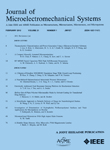
JOURNAL OF MICROELECTROMECHANICAL SYSTEMS
Scope & Guideline
Shaping Tomorrow's Technology through Scholarly Excellence
Introduction
Aims and Scopes
- Microfabrication Techniques:
The journal covers a wide range of microfabrication methods, including photolithography, etching, and bonding techniques, which are critical for the development of MEMS devices. - Sensor and Actuator Development:
Research on the design, development, and characterization of various types of sensors and actuators is a core focus, emphasizing their applications in fields like biomedical engineering, environmental monitoring, and consumer electronics. - Material Science in MEMS:
The exploration of advanced materials, including piezoelectric, ferroelectric, and nanomaterials, is essential for enhancing the performance of MEMS devices. - Modeling and Simulation:
The journal emphasizes computational modeling and simulation techniques to predict the behavior of MEMS devices under various operating conditions. - Applications of MEMS Technology:
Research on the application of MEMS technology in various domains, including telecommunications, automotive, medical devices, and aerospace, is a significant aspect of the journal.
Trending and Emerging
- Integration of MEMS with IoT:
There is a rising trend towards integrating MEMS devices with Internet of Things (IoT) applications, focusing on smart sensors and actuators that communicate data in real-time. - Energy Harvesting Technologies:
Research on MEMS devices for energy harvesting—particularly for biomedical and remote applications—has gained momentum, highlighting the need for sustainable and self-powered systems. - Advanced Materials for MEMS:
The use of novel materials, such as 2D materials and bio-compatible polymers, is increasingly featured, indicating a shift towards enhancing device performance and expanding application areas. - Microfluidics and Lab-on-a-Chip:
The development of microfluidic devices and lab-on-a-chip systems is trending, driven by applications in biomedical diagnostics and environmental sensing. - Wearable MEMS Devices:
The focus on wearable technology is growing, with research dedicated to MEMS devices that are compact, flexible, and capable of integrating with human physiology.
Declining or Waning
- Basic MEMS Theory and Principles:
There appears to be a waning focus on fundamental MEMS theory, possibly due to the maturation of the field and a shift towards applied research and advanced applications. - Conventional Actuation Mechanisms:
Research on traditional actuation mechanisms, such as electrostatic and thermal actuators, is decreasing as newer, more innovative actuation methods gain prominence. - Low-Temperature Fabrication:
The emphasis on low-temperature fabrication techniques has diminished, likely due to advancements in high-temperature materials and processes that enhance device performance. - Simple MEMS Devices:
Publications focusing on basic MEMS devices without innovative features or advanced functionalities are becoming less frequent as the field progresses towards more complex and multifunctional systems.
Similar Journals

Journal of Sensors and Sensor Systems
Fostering Interdisciplinary Research in SensorsThe Journal of Sensors and Sensor Systems, published by COPERNICUS GESELLSCHAFT MBH, is a prominent open-access journal that has been contributing to the fields of electrical and electronic engineering and instrumentation since its inception in 2012. With an ISSN of 2194-8771 and an E-ISSN of 2194-878X, this journal provides a critical platform for researchers, professionals, and students to disseminate innovative findings and advancements in sensor technology and system applications. As of 2023, it holds a respectable ranking in the third quartile for Electrical and Electronic Engineering and in the fourth quartile for Instrumentation, as per Scopus classifications. The journal is based in Göttingen, Germany, and emphasizes the importance of open access for broad dissemination of knowledge. By fostering interdisciplinary research and collaboration, The Journal of Sensors and Sensor Systems plays an essential role in advancing sensor technologies, ultimately driving progress in various scientific and engineering domains.
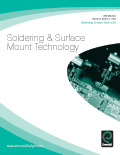
SOLDERING & SURFACE MOUNT TECHNOLOGY
Advancing Innovations in Soldering and Surface Mount TechnologySOLDERING & SURFACE MOUNT TECHNOLOGY is a prominent peer-reviewed journal published by Emerald Group Publishing Ltd in the United Kingdom, showcasing its commitment to advancing the fields of Electrical and Electronic Engineering, Condensed Matter Physics, and Materials Science. With a strong publication history dating back to 1989 and continuing through 2024, this journal provides a vital platform for disseminating innovative research and technological developments in soldering and surface mount technology. It holds a respectable ranking within its categories, including a Q3 classification in multiple fields according to the 2023 category quartiles, with Scopus rankings reflecting its growing influence in the academic community (e.g., #316/797 in Electrical and Electronic Engineering). While this journal does not offer open access, it remains an essential resource for researchers, practitioners, and students who aim to stay informed about cutting-edge advancements and trends in this dynamic area of study. By focusing on high-quality research contributions, SOLDERING & SURFACE MOUNT TECHNOLOGY continues to play a crucial role in fostering innovation and knowledge exchange within its scope.

Suranaree Journal of Science and Technology
Driving Discovery, Cultivating CollaborationSuranaree Journal of Science and Technology is an esteemed academic publication dedicated to fostering innovation and research in the interdisciplinary fields of engineering and technology. Published by Suranaree University of Technology in Thailand, this journal aims to disseminate high-quality research findings that contribute to the ongoing dialogue within the scientific community. With an ISSN of 0858-849X and an E-ISSN of 0858-849X, it provides an essential platform for researchers to share their work, though it is currently not open access. The journal's ranking in the bottom quartile (Q4) for Engineering (miscellaneous) as of 2023 highlights the competitive landscape it operates in, with Scopus rankings placing it at the 287th position out of 307 in the General Engineering category, indicating both the challenges and opportunities for growth within its network. As the journal converges from 2018 to 2024, it invites scholars, professionals, and students to contribute, ensuring the ongoing exchange of knowledge and advancements in the field.
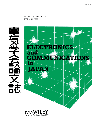
Electronics and Communications in Japan
Unlocking new horizons in electrical and electronic engineering.Electronics and Communications in Japan, published by WILEY, serves as a vital platform for researchers and practitioners in the fields of applied mathematics, electrical and electronic engineering, and computer networks and communications. With a focus on advancing the understanding and development of communication technologies, this journal has been disseminating valuable research since its inception in 1975, including significant contributions from 2008 to 2024. While it currently holds a Q4 ranking in several categories including Physics and Astronomy, Applied Mathematics, and Signal Processing, it offers an essential outlet for emerging ideas and practices in these disciplines. As an open-access journal, it ensures that cutting-edge research is accessible to a global audience, supporting collaboration and innovation within the academic community. With an ISSN of 1942-9533 and an E-ISSN of 1942-9541, Electronics and Communications in Japan not only contributes to the scholarly discourse but also plays a critical role in shaping the future of technology and communication.
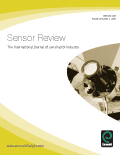
Sensor Review
Unveiling the Future of Sensor InnovationSensor Review, an esteemed journal within the fields of Electrical and Electronic Engineering as well as Industrial and Manufacturing Engineering, is published by EMERALD GROUP PUBLISHING LTD. With an ISSN of 0260-2288 and an E-ISSN of 1758-6828, this journal has been a crucial resource since its inception in 1981, now extending its coverage to 2024. Although currently classified as Q4 in Electrical and Electronic Engineering and Q3 in Industrial and Manufacturing Engineering for 2023, the journal is recognized for its significant contributions to sensor technology and applications, catering to both theoretical and practical dimensions of the field. Researchers and professionals engaged in sensor innovation and application will find Sensor Review an essential platform for disseminating cutting-edge research and fostering academic dialogue. While it does not offer open access, the journal's rigorous peer-review process and respectability in the academia ensure that published articles meet high scholarly standards. The journal’s impact is further reflected in its Scopus rankings, establishing it as a noteworthy publication among its peers.

Applied Science and Convergence Technology
Bridging Disciplines for a Technological TomorrowApplied Science and Convergence Technology (ISSN: 2288-6559) is a premier academic journal published by the Korean Vacuum Society, dedicated to advancing knowledge in the intersecting fields of condensed matter physics, electrical and electronic engineering, materials science, and theoretical chemistry. Based in South Korea, this journal serves as an essential platform for researchers, professionals, and students seeking to explore innovative applications and methodologies that drive convergence in science and technology. With a convergence period spanning from 2019 to 2024, the journal aims to publish high-quality original research and review articles that foster collaboration and knowledge sharing across disciplines. Its current quartiles position in top categories, alongside a respectable rank in Scopus, highlights its significance within the scientific community, although it is presently classified within lower tiers. The journal's commitment to open access ensures that vital research findings are accessible to a global audience, facilitating advancements in science and technology. As a notable outlet in its field, Applied Science and Convergence Technology continues to attract contributions that not only challenge current paradigms but also pave the way for future innovations.

Innovation and Emerging Technologies
Shaping the Future through Scholarly ResearchInnovation and Emerging Technologies, published by WORLD SCIENTIFIC PUBL CO PTE LTD, is a cutting-edge journal dedicated to advancing knowledge in the fields of technology, innovation, and their applications across various sectors. With ISSN 2737-5994 and E-ISSN 2810-9007, this journal aims to serve as a comprehensive platform for scholarly research and practical insights, fostering collaboration among researchers, professionals, and students alike. Although specific metrics such as impact factor and H-index are currently unavailable, the journal is poised to make significant contributions to the discourse surrounding emerging technologies and their societal implications. Emphasizing the importance of accessibility, the journal offers a range of options for engaging with its content, encouraging a wide readership and promoting the exchange of innovative ideas. Situated in Singapore, the journal reflects the region's commitment to technological advancement and global research, making it a pivotal resource for those dedicated to exploring the future of technology.
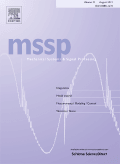
MECHANICAL SYSTEMS AND SIGNAL PROCESSING
Bridging critical fields to shape the future of technology.MECHANICAL SYSTEMS AND SIGNAL PROCESSING, published by Academic Press Ltd - Elsevier Science Ltd, is a leading journal that bridges multiple critical fields, including Aerospace Engineering, Civil and Structural Engineering, Computer Science Applications, Control and Systems Engineering, Mechanical Engineering, and Signal Processing. Established in 1987, this esteemed journal serves as an invaluable resource for researchers, professionals, and students seeking to advance the understanding of mechanical systems and their intimate relationship with signal processing techniques. With an impressive impact factor and consistently ranked in the Q1 category across various engineering and computer science disciplines, it offers rigorous peer-reviewed articles that contribute significantly to innovation and methodological advancements in the field. Although it does not currently offer Open Access options, its publication in the United States ensures a wide dissemination of high-quality research that shapes the future of engineering. The journal's convergence until 2025 promises to foster enduring discussions and collaborations that will continue to push the boundaries of technology and engineering applications.
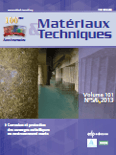
Materiaux & Techniques
Fostering Excellence in Material Science DiscourseMateriaux & Techniques, published by EDP SCIENCES S A, is a prominent journal in the field of materials science, specifically focusing on diverse and innovative techniques in material development and application. With an ISSN of 0032-6895 and an E-ISSN of 1778-3771, this French journal serves as a key resource for researchers and professionals looking to advance their knowledge and share their findings within the community. The journal holds a Q3 ranking in Materials Science (miscellaneous), indicating its role in contributing to various facets of material science research amidst a growing field. Despite operating under a traditional access model, it provides a platform for rigorous peer-reviewed studies and significant advancements in material technology. With a publication history tracing back to the late 1970s and extending through to 2024, Materiaux & Techniques continues to uphold its commitment to fostering high-quality discourse and innovation in materials science.

International Journal of Aeronautical and Space Sciences
Elevating Knowledge in Aeronautical SciencesThe International Journal of Aeronautical and Space Sciences, published by Springer, is a prominent platform dedicated to advancing research and innovation in the fields of Aerospace Engineering, Control and Systems Engineering, Electrical and Electronic Engineering, and Materials Science. With an ISSN of 2093-274X and an E-ISSN of 2093-2480, the journal has established itself as a vital resource since its inception in 2011, currently offering insights that span a wide range of contemporary challenges and technological advancements in aeronautics and space exploration. Ranking in the Q2 category across multiple disciplines, including Aerospace and Control Engineering, signifies its recognized impact and quality within the academic community. Although not an open-access journal, it remains accessible to researchers, professionals, and students seeking to enhance their understanding of complex aerospace systems and their applications. The journal’s commitment to publishing high-quality research makes it indispensable for those aiming to contribute to, or stay informed about, the evolving landscape of aerospace technology.